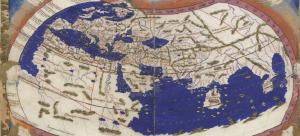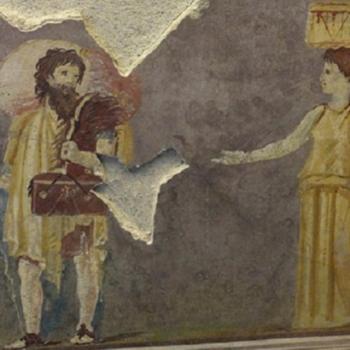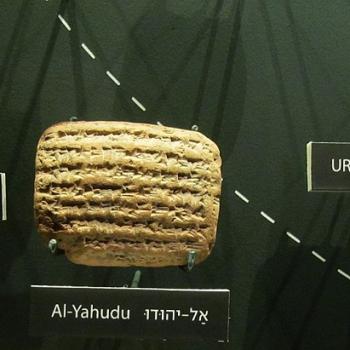People in Biblical times believed that the earth was flat? It’s a modern lie, designed to depict the ancients as too backward for us to listen to. We call this “chronological snobbery,” and in this case, even the premise is woefully exaggerated. It is amazing how much was known about the size and shape of the earth at this time.

400 years before Ptolemy, Eratosthenes had used the angles cast by the sun at the summer solstice to calculate the circumference of the earth at 252,000 stadia (28,970 miles), as Strabo tells us (Geography 2.5.7). Ptolemy is the first writer to articulate latitude. He does so using length of day at the summer solstice at a given point on the globe, which gets longer the further north one goes. Ptolemy even knows about the Arctic Circle, the place where 24-hour day and 24-hour night each happen once a year.
Strabo is familiar with identifiable locations from Iernē (Ireland) and Thulē (Norway) to Taprobanē (Sri Lanka, which he called the “Cinnamon-Producer”) and Labadius (Java). He knows of the Golden (probably Malay) Peninsula, and the Great Gulf (Magnus Sinus). All of this belonged to what was called India Trans Gangem (India Across the Ganges). Long before Columbus, Strabo declares that “if the immensity of the Atlantic Ocean did not prevent it, we could sail from Iberia to India.”
Ptolemy relies partly on information from Marinus of Tyre (early second century AD), and partly on the help of a Greek sailor named Alexander. Alexander tells that the eastern destination for Roman traders was a Burmese city called Tamala on the Malay Peninsula, where Eastern merchants then crossed to reach the Perimulic Gulf (Gulf of Thailand). He knows an important port city in the Far East called Cattigara, which has been identified close to Saigon, the former capital of South Vietnam. Ptolemy thinks that the two Latin names for China refer to different locations; to him, Serica (at the end of the Silk Road) is not the same place as Sinae, the land of the Qin dynasty. Ptolemy also knows Africa as far as the mountains of Mozambique, from where he says there are another 74 degrees to the Pole.
A first century AD Greek text called the Periplus of the Erythraean Sea (https://sourcebooks.fordham.edu/ancient/periplus.asp) is another account of lands bordering the eastern Indian Ocean, written by an unnamed merchant. This writer also knows of a place that he pronounces Thinae, a great city where silk originates, in a land that stretches from the East all the way to the Caspian Sea. Even Josephus (Antiquities 8.164) knows enough about the Far East to theorize that the Golden Land (Aurea Chersonesus), which he says “belongs to India,” is actually Ophir, the place from which Solomon and his Phoenician ships imported huge amounts of gold (1 Kings 10:11, 22).
So people in the first century AD Biblical world were not locked in to the concept of a flat earth made up of Europe, northern Africa, and western Asia. Now, knowledge of the world was a bit sketchier when we go back a few centuries. The best maps we have for the ancient world from Iron Age II are the Sargon Geography map (eighth century BCE – see Wayne Horowitz, Mesopotamian Cosmic Geography – text at http://www.aakkl.helsinki.fi/melammu/database/gen_html/a0000526.php), and – surprise! – the Table of Nations in Genesis 10. Kenneth Kitchen has demonstrated that this chapter most likely reflects a tenth-century BCE date, based on the nations that appear and do not appear in it (Kitchen, On the Reliability of the Old Testament).
So what was the Hebrew conception of the earth? The word eretz (used over 2500 times in the Hebrew Bible) was broad enough to mean “earth” as opposed to “sky / heaven” (Genesis 1:1), “land” in a more local sense (Genesis 12:1), “piece of property” (Genesis 23:15), or even “ground” in a directional sense (Genesis 18:2). However, the word tēbēl (used 36 times) is a narrower term, virtually always meaning “world” or “planet.” Sometimes eretz and tēbēl are paired as poetic synonyms; sometimes they are glued together into a single expression (Job 37:12) to mean “the whole earth.” Interestingly, the Greek version usually uses oikoumenē (inhabited world) to translate tēbēl, while Jerome, working around 400 AD, uses the Latin orbis, which can mean either a circle or a sphere.
The same Job who refers to the “pillars” of the earth in Job 9:6 (mentioned elsewhere only in Psalm 75:4, and in 1 Samuel 2:8, where a different word for pillar is used) also says in Job 26:7 that God “hangs the earth upon nothing.” Neither description needs to be taken as an authoritative teaching on geology, especially not in a context from the mouth of Job. The “foundations of the earth” (mentioned only in 2 Samuel 22:16 = Psalm 18:16, and Isaiah 40:21) are less difficult to explain from our point of view than pillars; we may understand them as the “core” or mantle upon which the earth’s crust rests.
Today’s post is the first of several posts dealing with issues in early Genesis. Log on next time, when we’ll take a closer look at the meaning of “creation,” and the method and timetable by which it happened, followed by posts on the nature of the “firmament,” what were the “sea monsters” created on the fifth day, and what does “dominion” over creation mean? And more!












